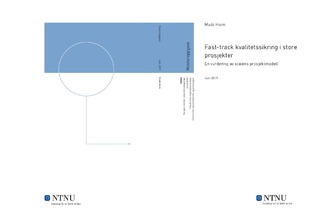| dc.description.abstract | Statens prosjektmodell kan sees på som en sekvensiell faseinndelt modell med to kontrollpunkter i prosjektenes tidligfase. Modellen starter med idefasen før det blir gjennomført en konseptvalgutredning (KVU). Deretter blir KVU'en kvalitetssikret ved en kvalitetssikring av konseptvalg(KS1) før det blir tatt en regjeringsbeslutning om konseptvalg. Den neste fasen er forprosjektet der lønnsomhet, gjennomførbarhet og andre kriterier blir vurdert før faktisk gjennomføring av prosjektet. Videre er neste steg en kvalitetssikring av styringsunderlag og kostnadsoverslag (KS2) før det blir tatt en beslutning på Stortinget for gjennomføring av prosjektet. Det er i denne oppgaven gjort en vurdering av modellen og kommet fram til mulige endringer for å effektivisere prosessen. Hovedfokus er på hvilke prosesser i statens prosjektmodell (KS-ordningen) som er mest tid- og kostnadskrevende, hvorvidt noe kan endres med prosessene for å øke effektiviteten, om oppgavene i kvalitetssikringen kan filtreres etter type prosjekt og hvordan kvalitetssikringen bør vektlegges ved lufthavndesign. For å få et dypere innblikk i hvordan kvalitetssikringen gjennomføres er prosjektet "Ny lufthavn Bodø" brukt som case. Et prinsipp som er mulig å gjennomføre for raskere løsninger er fast-tracking. Fast-tracking går ut på å utføre aktiviteter parallelt i stedet for sekvensielt for å korte ned på tidsbruken. Denne metoden er riktignok kun mulig å bruke dersom aktivitetene faktisk kan overlappes.
Litteraturstudie og kvalitative intervjuer ble benyttet for å innhente informasjon om og erfaringer fra både statens prosjektmodell, metoder for raskere gjennomføring av kvalitetssikring og store prosjekter generelt. Kvalitative intervjuer var spesielt nyttig ettersom det ikke foreligger mye litteratur omkring KS1. Intervjuene ga inntrykk av enighet blant intervjuobjektene om at det i stor grad er mulig å tilpasse kvalitetssikringen til type prosjekt. Dette kan blant annet gjøres ved å legge mindre vekt på deler av prosessen i enkelte prosjekter.
Saksbehandlingstid i departementer og direktorater ble ofte pekt på av flere som en medvirkende årsak til tid-og kostnadsoverskridelser. Nøyaktigheten i usikkerhetsvurderingene ble også nevnt som avgjørende for å holde prosjekter innenfor tid- og kostnadsrammer. Mulige endringer som ble foreslått for statens prosjektmodell var blant annet tidligere involvering av entreprenør og større grad av parallellitet i den første delen av kvalitetsikringen. Ved å gjennomføre KVU og deler av KS1 samtidig kan det være muligheter for både tid- og kostnadsbesparelser. Studien resulterte i utviklingen av et rammeverk for tilpasning av kvalitetssikringen til type prosjekt, i tillegg til en anbefaling til Avinor for kvalitetssikring av prosjektet "Ny lufthavn Bodø". Begge disse løsningene inneholdt en grad av parallellitet i den første fasen av kvalitetssikringen. | |
| dc.description.abstract | The governmental model for large investment projects in Norway can be seen as a sequential phase model with two points of control in the early phase of projects. At first, the idea phase is finished, before the next step is the concept study. Then, the previous stage is being quality assured through the quality assurance of the choice of concept before the governmental decision is taken on the choice of concept. The next phase is the feasibility study where profitability, feasibility and other criteria are considered before the actual implementation of the project can be done. Furthermore, the next step is the quality assurance of the management documentation and the cost estimate before a decision is made at the parliament regarding the start of the project. In this thesis, an assessment of the model has been made, and it has been discovered possible changes to increase the efficiency of the process. The main focus was among others given to which processes are the most time and cost consuming in the quality assurance in the governmental model for large investment projects and if anything could be altered within the processes to increase efficiency. The possibility to "filter" the tasks in the quality assurance concerning the type of project, and how quality assurance should be emphasized within airport design was also considered. To get a more in-depth insight into how quality assurance is carried out, the project regarding a new airport in Bodø, Norway, is used as a case study. A principle which is possible to implement to gain faster processes is fast-tracking. Fast-tracking is performing activities in parallel rather than sequentially to obtain a shorter time used on the process in focus. It is crucial to notice that this method can only be used if the activities actually can be overlapped.
A literature study and qualitative interviews were used to obtain information and experiences from both the governmental model for large investment projects and methods for faster quality assurance and projects in general. Qualitative interviews were especially useful as there is no significant amount of literature available regarding the quality assurance of the choice of concept. Interviews resulted in an impression of unity among the interview objects that it is certainly possible to adopt the quality assurance process to the type of project and that in some projects different parts of the quality assurance process may be given less importance.
Processing time in ministries and directorates was often mentioned as a factor to time and cost overruns. The accuracy of the uncertainty assessments pointed to as essential to keep the project within the time and cost limits. Possible changes proposed to the governmental model for large investment projects include earlier involvement of entrepreneur and parallelism in the first part of the quality assurance. By conduction the concept study and parts of the quality assurance of the concept choice at the same time, there could be opportunities for both time and cost savings. A framework was developed for adapting the quality assurance to different types of projects in addition to a recommendation to Avinor for quality assurance of the project concerning a new airport in Bodø, Norway. Both of these proposals for solutions contained a degree of parallelism in the first phase of quality assurance. | |
